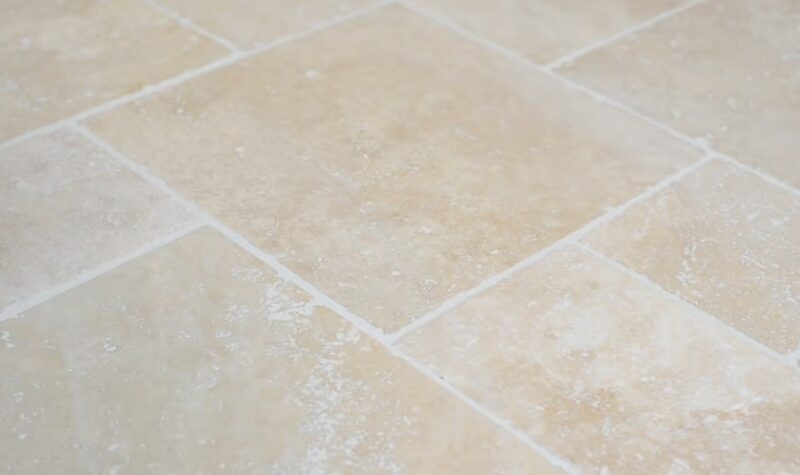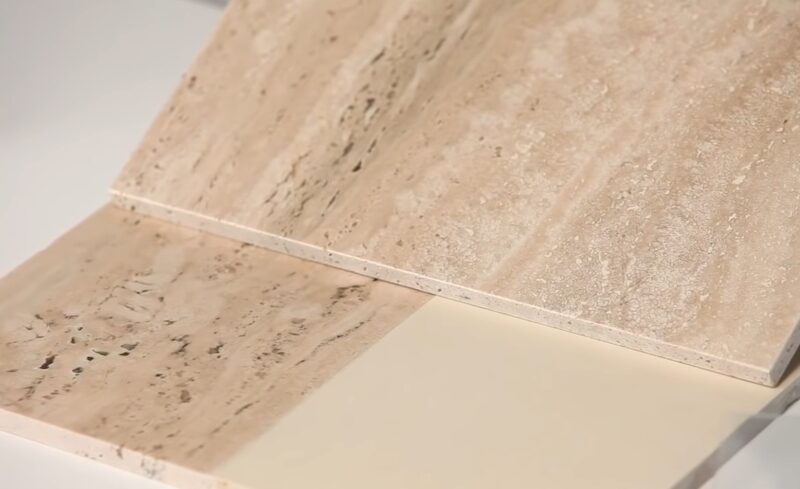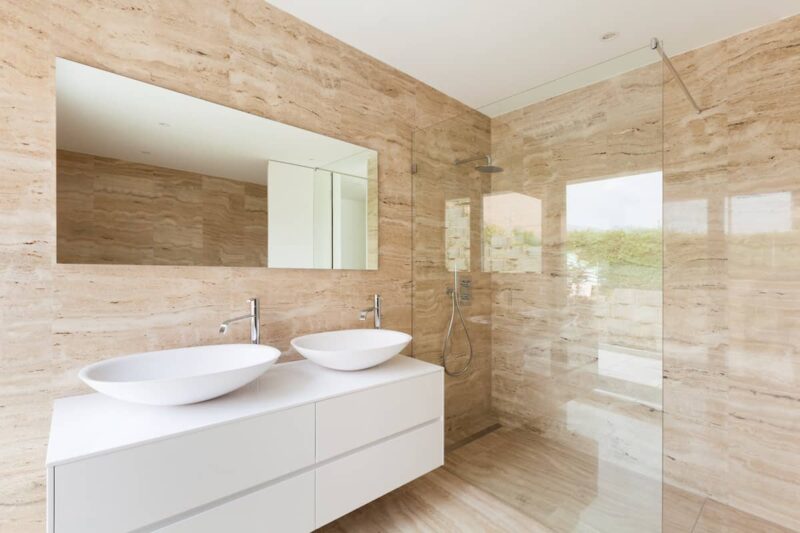Having lived with both travertine and marble tiles in my home, I know firsthand how each offers its own kind of beauty and functionality. Both stones have uplifted the aesthetics of my spaces in different ways, yet they also presented unique challenges in terms of maintenance and cost.
Through this blog post, I’ll share valuable insights, aiming to guide you in making a decision that you’ll be happy with for years to come—both aesthetically and financially.
Our team has also written an article about the best tiles for shower floors, so make sure to check it out. Now, without further ado, let us begin!
If You’re In a Hurry…
I’ve summarized the basics you need to know if you are in a hurry:
| Travertine | Marble | |
| Average Cost (per sq ft) | $2 – $5 | $5 – $50 |
| Maintenance | Moderate | High |
| Environmental Impact | Lower | Higher |
| Best For | Outdoor, Flooring | Bathroom, Kitchen |
| Durability | Good | Excellent |
Travertine Explained

Travertine is a form of limestone that occurs naturally in hot springs and limestone caves. It has a unique, rustic appearance, which can bring a touch of nature into your home. Travertine tiles are frequently used in outdoor spaces and can also be found gracing the interiors of various residential and commercial properties.
Characteristics and Applications
The characteristic feature of travertine is its porous surface filled with tiny holes. These holes are often filled and then polished or honed to create different finishes. You can have a glossy or matte finish, depending on your preference. In terms of color, travertine generally comes in natural tones of beige, brown, and cream.
Travertine tiles are usually used for flooring but can also be used for countertops, backsplashes, and wall cladding. Their earthy tones lend a warm and inviting atmosphere to any space. They’re especially popular for outdoor areas like patios and pool decks because they are heat resistant and remain cool to the touch even in hot weather.
Marble Explained
Marble is a luxurious and elegant stone that has been a symbol of sophistication for centuries. It is metamorphic, originating from limestone that has been subjected to high pressure and heat. Marble tiles are versatile and can add a touch of elegance to any room, although they’re most commonly used in bathrooms and kitchens.
Characteristics and Applications
Marble tiles come in various hues, including white, black, green, and pink, among others. They are characterized by their veining, which can be subtle or quite pronounced. Unlike travertine, marble has a smooth and less porous surface, which gives it a glossy finish when polished.
These tiles are often used for flooring, countertops, and wall applications. However, they can be quite slippery when wet, so they’re not commonly used in high-moisture or outdoor areas without additional treatment. Marble is also a popular choice for artistic installations and sculptures, thanks to its smooth surface and range of colors.
Comparing Costs
Travertine ─ The Budget-Friendly Choice
If you are looking for a more budget-friendly option, travertine usually wins the round. On average, travertine tiles can cost anywhere from $2 to $5 per square foot, depending on the quality and finish. The installation costs are also generally lower due to the ease of cutting and handling the material.
Marble ─ A Pricier Investment
Marble, on the other hand, can be significantly more expensive. The cost of marble tiles can range from $5 to $50 per square foot, depending on the type and quality. Installation can also be more labor-intensive, which could increase the overall cost. However, many people find the luxurious look of marble to be well worth the investment.
Maintenance and Durability

Travertine
Travertine is porous, which makes it susceptible to staining. However, this can be mitigated by applying a sealant. It’s advisable to reseal the tiles every one to two years to maintain their appearance. For cleaning, mild soap and water are usually sufficient, and harsh chemical cleaners should be avoided to prevent damaging the surface.
Marble
Marble requires a bit more care compared to travertine. It is sensitive to acidic substances like lemon and vinegar, which can cause etching on the surface. Therefore, marble tiles should be sealed more frequently, ideally every 6 to 12 months. When cleaning, it’s best to use a pH-neutral cleaner to avoid damaging the stone.
Environmental Impact
Travertine
Travertine has a relatively lower environmental impact compared to marble. This is mainly because it is often found in larger quantities and is easier to extract. The energy consumption during its extraction and production is generally lower. Plus, its durability means it doesn’t have to be replaced as frequently, contributing to its sustainability.
Marble
Marble extraction can be more energy-intensive and may involve more complex transportation logistics due to its weight. Additionally, the process of making marble shiny and polished involves the use of various chemicals, which can have an environmental impact.
However, because marble lasts a very long time, it may not need to be replaced as often, somewhat offsetting its initial environmental cost.
Which One is Right for You?

Consider Your Needs
When choosing between travertine and marble, think about where you’ll be using the tiles. If you’re aiming for an outdoor setting or perhaps a more rustic look, travertine may be the way to go. On the other hand, if you’re seeking to add a touch of luxury and sophistication, particularly in an indoor setting like a bathroom or kitchen, marble might be more suitable.
Value for Money
While travertine is generally more affordable, it doesn’t mean it’s the best choice for every situation. If you’re looking for a long-lasting investment that adds to the value of your home, marble’s higher cost might be justifiable. But if you want a beautiful yet functional option without breaking the bank, travertine offers excellent value for money.
FAQs
Can I use travertine or marble in a high-traffic area like a hallway or foyer?
Travertine can be a good choice for high-traffic areas due to its durability and resistance to wear and tear. However, it’s crucial to keep in mind that its porous nature may require more frequent sealing to prevent stains.
Marble can also be used in high-traffic areas, but it tends to show wear more easily, especially in lighter colors. Both stones are strong but may require different levels of maintenance in high-traffic spaces.
Which is better for a kitchen countertop: travertine or marble?
Marble is generally more suitable for kitchen countertops because of its smooth surface and luxurious look. However, it’s essential to be mindful that marble is susceptible to etching from acidic substances like lemon juice or vinegar.
On the other hand, travertine’s porous nature makes it less ideal for countertops where spills are frequent, as it can be prone to staining.
Are travertine and marble tiles suitable for use in bathrooms?
Both travertine and marble are commonly used in bathrooms. Travertine offers a rustic and earthy aesthetic, but its porous nature may require more frequent sealing to avoid water damage.
Marble is often considered the go-to choice for a luxurious bathroom setting but can be slippery when wet, so using honed rather than polished marble tiles is recommended for floors.
Can travertine or marble tiles be used with underfloor heating?
Yes, both travertine and marble tiles can be used with underfloor heating systems. They conduct heat well, making them a good choice for this type of installation.
However, it’s important to consult with your installer to ensure that the heating system is appropriate for the stone you choose, as different stones have varying degrees of thermal conductivity.
How do the weights of travertine and marble compare?
Both travertine and marble are relatively heavy materials, but marble is generally denser and, therefore, heavier. This may impact the installation process, especially if you’re considering a DIY approach. The structural integrity of the area where you plan to install the tiles should be assessed to ensure it can handle the weight.
Can I mix travertine and marble tiles in the same space?
Yes, you can mix travertine and marble tiles in the same space, but it’s essential to have a cohesive design plan to ensure that the different materials complement each other. Mixing stones can create a unique and customized look but may require extra planning and a keen eye for design to make the space visually harmonious.
Final Words
Both travertine and marble have their unique sets of advantages and drawbacks. Your choice between the two will largely depend on your specific needs, aesthetic preferences, and budget. Either way, both stones offer a timeless beauty that can enhance the look and feel of your home. Choose wisely, and you’ll be enjoying the fruits of your labor for years to come.

